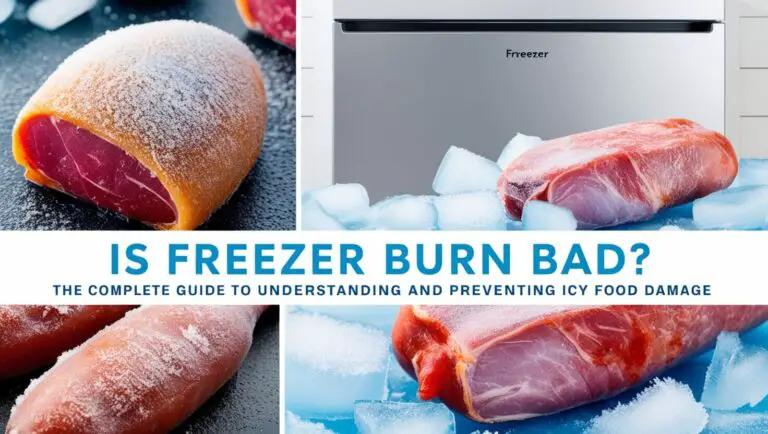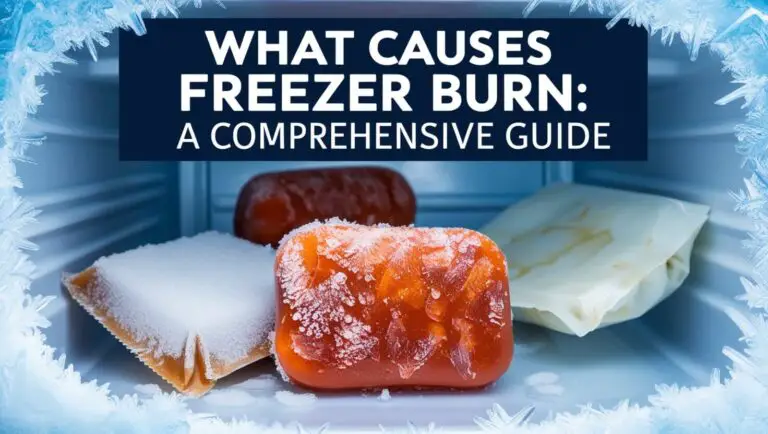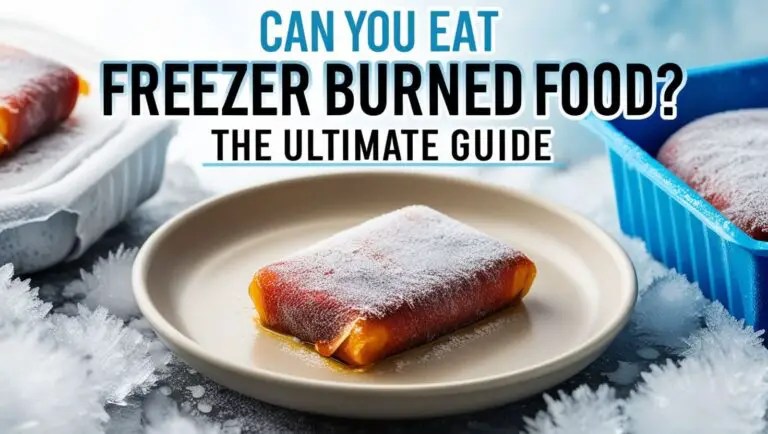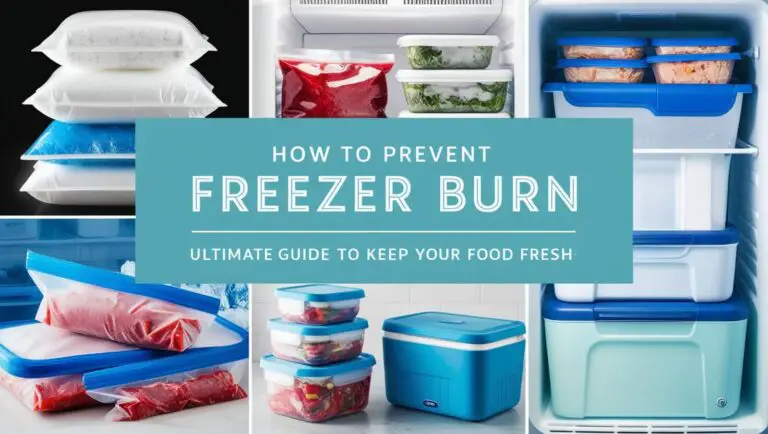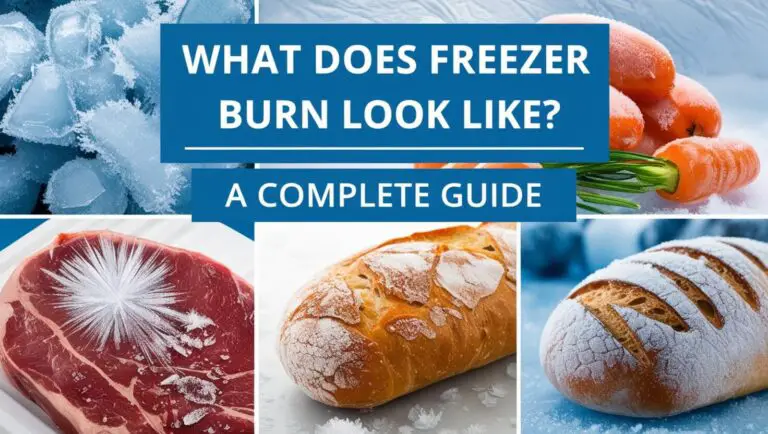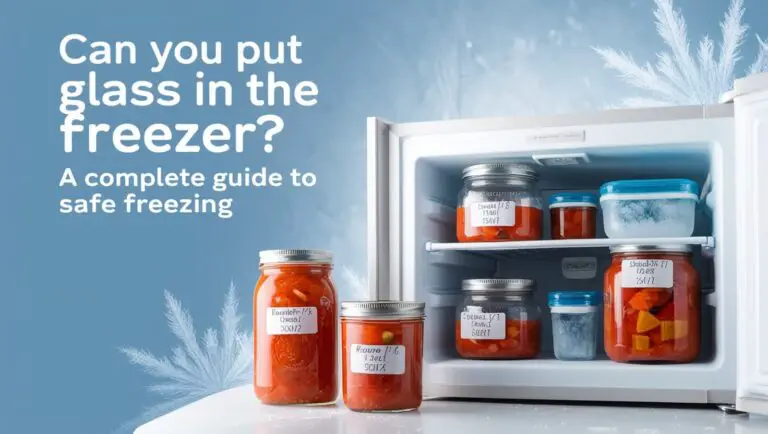What Is Freezer Burn? Preventing Food Damage
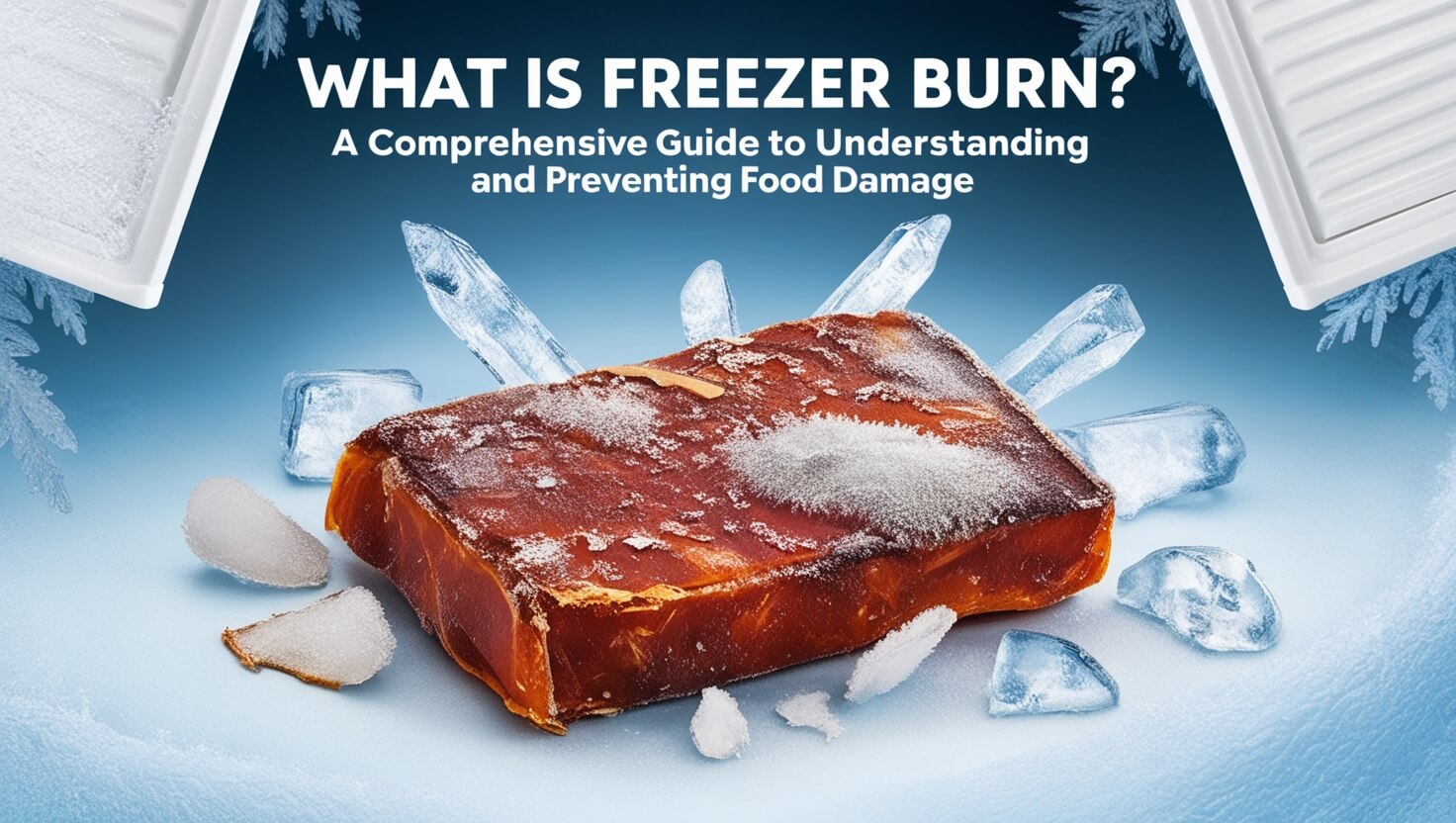
Freezer burn is a common issue that affects frozen foods, altering their taste, texture, and appearance. It occurs when food loses moisture in the freezer, resulting in dry, discolored patches. While freezer burn doesn’t make food unsafe to eat, it can significantly impact its quality. In this guide, we’ll explore what freezer burn is, how to identify it, and most importantly, how to prevent it from affecting your frozen foods.
The Science Behind Freezer Burn
Definition of Freezer Burn
Freezer burn is a condition that happens when frozen food loses moisture due to exposure to air in the freezer. This process leads to dehydration and oxidation of the food’s surface, causing visible changes and affecting the overall quality of the frozen item.
The Process of Sublimation
At the heart of freezer burn is a process called sublimation. This occurs when ice on the surface of frozen food turns directly into water vapor without passing through the liquid state. The dry, cold air in the freezer causes this moisture to evaporate from the food’s surface, leading to the characteristic symptoms of freezer burn.
How Freezer Burn Affects Food on a Molecular Level
On a molecular level, freezer burn disrupts the structure of food. As water molecules escape, they leave behind empty spaces in the food’s cellular structure. This change can alter the texture, making food tough or spongy. Additionally, the loss of moisture can concentrate flavors, often resulting in an unpleasant taste.
Identifying Freezer Burn in Different Foods
Appearance of Freezer Burn on Meats
Freezer burn on meats is often easy to spot. Look for:
- Gray or brown discolored patches
- Dry, leathery texture on the surface
- White or grayish-brown spots
These signs indicate that the meat has lost moisture and been exposed to air in the freezer.
How Freezer Burn Affects Fruits and Vegetables
Fruits and vegetables with freezer burn may show:
- Discoloration or fading of natural colors
- Dry, shriveled appearance
- Visible ice crystals on the surface
The high water content in fruits and veggies makes them particularly susceptible to freezer burn.
Spotting Freezer Burn in Ice Cream and Frozen Desserts
In ice cream and other frozen desserts, freezer burn manifests as:
- Large ice crystals on the surface
- Dry, chalky texture
- Loss of flavor and creaminess
These changes can significantly impact the enjoyment of your favorite frozen treats.
Causes of Freezer Burn
Temperature Fluctuations and Their Impact
Frequent or significant temperature changes in your freezer can accelerate freezer burn. When temperatures fluctuate, it causes the moisture in foods to repeatedly freeze and thaw, leading to more rapid moisture loss and ice crystal formation.
Air Exposure: The Primary Culprit
The main cause of freezer burn is exposure to air. When food isn’t properly sealed, the dry air in the freezer draws out moisture, leading to dehydration and oxidation. This is why proper packaging is crucial in preventing freezer burn.
Length of Storage and Its Effects
The longer food stays in the freezer, the more likely it is to develop freezer burn. Even well-packaged foods can eventually succumb to freezer burn if stored for extended periods.
Is Freezer-Burned Food Safe to Eat?
Food Safety Considerations
The good news is that freezer burn doesn’t make food unsafe to eat. The process doesn’t introduce harmful bacteria or pathogens. However, it can significantly affect the quality and enjoyment of the food.
Nutritional Impact of Freezer Burn
While freezer burn primarily affects taste and texture, it can also impact the nutritional value of food. The loss of moisture can concentrate some nutrients, while the oxidation process may degrade others, particularly vitamins.
When to Discard Freezer-Burned Food
Although freezer-burned food is safe, there comes a point when it’s best to discard it:
- If the freezer burn is extensive and affects most of the food
- When the taste or texture has become unpalatable
- If there are signs of spoilage in addition to freezer burn
Use your judgment and consider the extent of the freezer burn when deciding whether to use or discard affected foods.
The Impact of Freezer Burn on Food Quality
Texture Changes in Freezer-Burned Foods
One of the most noticeable effects of freezer burn is the change in texture:
- Meats become tough and leathery
- Fruits and vegetables turn mushy or rubbery
- Ice cream becomes grainy and loses its smooth texture
These texture changes can significantly impact the eating experience.
Flavor Alterations Due to Freezer Burn
Freezer burn can dramatically affect the taste of food:
- Loss of natural flavors
- Development of a stale or “freezer” taste
- Increased blandness due to moisture loss
These flavor changes can make even your favorite foods less enjoyable.
Color Changes Associated with Freezer Burn
Visual changes are often the first sign of freezer burn:
- Meats may develop gray or brown spots
- Fruits and vegetables can become pale or discolored
- Ice cream may develop a yellowish tint
These color changes, while not harmful, can make food less appetizing.
Preventing Freezer Burn: Best Practices
Proper Packaging Techniques
Effective packaging is your first line of defense against freezer burn:
- Remove as much air as possible from packaging
- Use freezer-specific bags or containers
- Double-wrap foods for extra protection
- Consider using a vacuum sealer for long-term storage
Proper packaging creates a barrier between the food and the dry freezer air.
Optimal Freezer Temperature Settings
Maintaining the right freezer temperature is crucial:
- Set your freezer to 0°F (-18°C) or below
- Use a freezer thermometer to monitor temperature
- Avoid frequent temperature fluctuations
A consistently cold freezer helps prevent the formation of large ice crystals that contribute to freezer burn.
Organizing Your Freezer for Better Food Preservation
Smart freezer organization can help prevent freezer burn:
- Store frequently used items near the front
- Rotate foods to use older items first
- Don’t overpack the freezer; allow for air circulation
- Keep a freezer inventory to track storage times
Good organization reduces the time the freezer door is open, helping maintain a consistent temperature.
How to Minimize Freezer Burn on Specific Foods
Protecting Meat from Freezer Burn
To keep your meats fresh in the freezer:
- Wrap tightly in plastic wrap or freezer paper
- Place wrapped meat in a freezer bag, removing excess air
- Label with the date and use within recommended timeframes
- Consider portioning meat before freezing for easier thawing
Preserving Fruits and Vegetables in the Freezer
For fruits and vegetables:
- Blanch vegetables before freezing to preserve color and nutrients
- Freeze fruits on a tray before packaging to prevent clumping
- Use air-tight containers or freezer bags
- Add a small amount of sugar or syrup to fruits to help preserve texture
Keeping Ice Cream and Desserts Free from Freezer Burn
To maintain the quality of frozen desserts:
- Store ice cream in the main part of the freezer, not the door
- Keep the original container tightly closed
- Place a layer of plastic wrap directly on the surface of the ice cream
- Scoop from one area of the container to minimize exposure
Dealing with Freezer-Burned Food
Salvaging Freezer-Burned Meats
If your meat has minor freezer burn:
- Trim off affected areas before cooking
- Use in dishes with strong flavors or sauces to mask any taste changes
- Consider using in soups or stews where texture changes are less noticeable
Using Freezer-Burned Fruits and Vegetables
For fruits and vegetables with freezer burn:
- Use in smoothies or purees where texture is less important
- Incorporate into baked goods or cooked dishes
- Consider making jams or sauces to use up freezer-burned fruits
Creative Ways to Use Freezer-Burned Foods
Don’t let freezer-burned food go to waste:
- Use meat in casseroles or heavily spiced dishes
- Blend fruits into popsicles or sorbets
- Use vegetables in soups or pot pies
- Turn freezer-burned bread into croutons or breadcrumbs
Freezer Burn vs. Other Food Storage Issues
Freezer Burn vs. Freezer Frost
While both involve ice, freezer burn and freezer frost are different:
- Freezer burn affects the food itself, causing dehydration
- Freezer frost is ice buildup on the freezer walls or exterior of packages
- Frost can contribute to freezer burn by introducing moisture
Distinguishing Between Freezer Burn and Spoilage
It’s important to differentiate freezer burn from spoilage:
- Freezer burn affects quality but not safety
- Spoilage involves bacterial growth and can be dangerous
- Spoiled food may have off-odors, unusual colors, or slimy textures
When in doubt, it’s better to discard food that shows signs of spoilage.
Freezer Burn in Relation to Freezer Storage Times
Understanding storage times can help prevent freezer burn:
- Different foods have different optimal freezer storage times
- The longer food is stored, the more likely it is to develop freezer burn
- Use a first-in, first-out system to rotate freezer contents
Knowing proper storage times helps maintain food quality and reduce waste.
Advanced Tips for Long-Term Freezer Storage
Vacuum Sealing: Pros and Cons
Vacuum sealing can be an effective way to prevent freezer burn:
Pros:
- Removes air, reducing the risk of freezer burn
- Extends freezer storage life
- Saves space in the freezer
Cons:
- Requires special equipment
- Can be time-consuming
- May crush delicate foods
Flash Freezing Techniques
Flash freezing can help preserve the quality of certain foods:
- Spread food items in a single layer on a baking sheet
- Freeze until solid (usually 1-2 hours)
- Transfer to long-term storage containers
This method helps prevent clumping and can reduce ice crystal formation.
Using Freezer-Safe Containers and Materials
Choosing the right storage containers is crucial:
- Use containers specifically designed for freezer use
- Glass containers with tight-fitting lids work well
- Avoid using containers with narrow openings, which can trap air
- Consider silicone freezer bags for an eco-friendly option
Common Myths About Freezer Burn Debunked
Myth: Freezer Burn Makes Food Unsafe
Truth: While freezer burn affects quality, it doesn’t make food unsafe to eat. The process doesn’t introduce harmful bacteria or pathogens.
Myth: You Can’t Prevent Freezer Burn
Truth: While it’s challenging to prevent freezer burn indefinitely, proper packaging and storage techniques can significantly delay its onset.
Myth: All Ice Crystals Mean Freezer Burn
Truth: Not all ice crystals indicate freezer burn. Some ice formation is normal in frozen foods. Freezer burn is characterized by dry, discolored patches.
The Role of Modern Freezer Technology in Preventing Freezer Burn
Features of Frost-Free Freezers
Frost-free freezers can help reduce freezer burn:
- They automatically defrost periodically
- This prevents frost buildup, which can contribute to freezer burn
- However, the defrosting cycle can cause slight temperature fluctuations
Smart Freezers and Temperature Monitoring
New smart freezer technologies offer benefits:
- Constant temperature monitoring and adjustment
- Alerts for temperature fluctuations or power outages
- Some models have specific modes for rapid freezing
These features can help maintain optimal conditions to prevent freezer burn.
Specialized Freezer Compartments and Their Benefits
Many modern freezers offer specialized storage options:
- Quick-freeze drawers for rapid cooling
- Adjustable humidity controls for different food types
- Vacuum-sealed compartments for extended storage
These features can help tailor storage conditions to different foods, potentially reducing freezer burn.
In Closing: Mastering Freezer Burn Prevention for Better Food Quality
Understanding what freezer burn is and how it affects your food is the first step in preventing it. By implementing proper packaging techniques, maintaining optimal freezer conditions, and being mindful of storage times, you can significantly reduce the risk of freezer burn. Remember, while freezer-burned food is safe to eat, preventing freezer burn helps maintain the taste, texture, and nutritional value of your frozen foods.
With the tips and knowledge provided in this guide, you’re now well-equipped to keep your frozen foods in top condition. By taking proactive steps to prevent freezer burn, you’ll reduce food waste, save money, and ensure that your frozen meals are always delicious and enjoyable. Keep these strategies in mind, and you’ll be on your way to mastering the art of frozen food storage.

